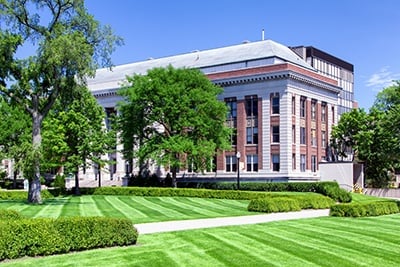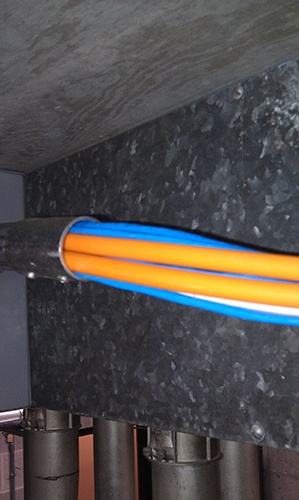 Modern higher education is increasingly underpinned by technology. Whatever the subject, teaching, research and administration all rely on the fast transmission of data to students, professors and staff.
Modern higher education is increasingly underpinned by technology. Whatever the subject, teaching, research and administration all rely on the fast transmission of data to students, professors and staff.
And with intense competition for the best students and researchers, a slow network can mean the brightest minds go elsewhere.
High speed fiber networks are therefore crucial parts of the infrastructure of university and college campuses across the world.
The challenges of campus networking
Rolling out a fiber network across a university campus is complex and potentially costly for four key reasons:
- The lack of easy access to campus buildings
- The range and number of buildings on a university campus
- Existing building conduits are often crowded and difficult to route fiber through
- University buildings can date back centuries and be works of art in their own right, making the aesthetics of a fiber deployment crucial
These are big challenges that are not unusual in many fiber to the premises installations, but the good news is that with advancements in network planning, products and deployment techniques, projects can now be tackled economically, ensuring that fiber is installed efficiently, and protected for the long-term.
This blog will outline how microduct can be used to manage and protect fiber while ensuring a cost-effective broadband installation. A microduct is essentially a small, flexible conduit that can fit through the tightest gaps, while still being flexible enough to bend around obstacles and strong enough to resist crushing and damage. There are three key areas where it meets the challenges outlined above:
1. Microduct and microtrenching in outside plant
University authorities want the minimum amount of disruption on their campus when the fiber network is being deployed. Microtrenching helps here – rather than completely digging up the parking lot or the carefully manicured college lawns, it involves making a one-inch wide saw cut about nine to twelve inches deep. Because of its size you can even use existing expansion joints in a concrete walkway or sidewalk. Once the cut is made, teams can simply place microducts into the trench and backfill it.
One of the key advantages of microtrenching is that disruption is minimized - it is even possible to trench across one lane of the road and then allow traffic to cross over the trench while the other lane of traffic is cut. It’s also possible to let traffic drive on it minutes after it’s sealed without risk of damage. And when backfill is complete, it is not unusual for the trench to be virtually invisible.
From the microtrench the microduct can then be routed to a wall box or server rack within a building. Fiber is therefore protected all the way into the facility, technicians can access the connectors without risk of damage and it can be easily broken out for distribution.
 2. Dealing with riser congestion
2. Dealing with riser congestion
There’s a lot of existing infrastructure already in place in campus buildings, meaning that conduits are often extremely congested. Adding new conduits takes up space and is expensive, so is normally not an option. Microduct is designed to fit into the tightest spaces and combines sufficient rigidity to allow it to be pushed, but flexible enough to go round bends in the conduit. A good example of where this worked in a similar scenario to a campus was rolling out fiber to a 10th floor cell tower. Involving 22 90 degree bends, a 1 inch, already occupied electrical conduit and two 24 fiber cables, the job was completed in just 8 hours using microduct, amazing both contractor and client.
3. Gigabit to the Dormitory
When it comes to technology and the internet, students are amongst the most demanding of customers. They want the ability to stream video in real-time and download and play music, as well as access the web to shop, order takeouts and chat to friends on social media. Occasionally they might even download a lesson or do some research for that paper that’s due in a couple of hours time.
So deploying fiber to student housing is vital. Dorm buildings come in all shapes and sizes, but the majority closely resemble tower type Multiple Dwelling Units (MDUs). This means using risers within the building, which again are often heavily congested. The small footprint of microducts, coupled with their rugged nature, makes them easy to install without risk of damage, either during deployment or when in use. As microducts can be terminated in boxes on any or all floors, network designers can place access points exactly where they are needed and can be used for pass through or point-to-point fiber optic installations.
No splicing is needed on the floor if you are using pre-terminated pushable fiber as the installer simply pushes or pulls the pre-connectorized fiber to the desired room through the microduct, takes off the protective cover and slides on the connector housing. This reduces the skill level (and consequent cost) for the job, as well as speeding up deployments.
Getting straight As for campus fiber
As we’ve said, delivering high speed broadband to the campus is a necessity if colleges and universities are going to recruit and retain students and researchers. The structure and set-up of the campus poses unique challenges – but the combination of microducts, microtrenching and pre-connectorized fibers provide the toolkit for your deployment to earn the highest grades for efficiency, speed and reduced cost.



Comments